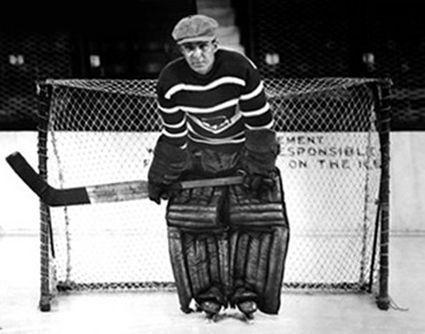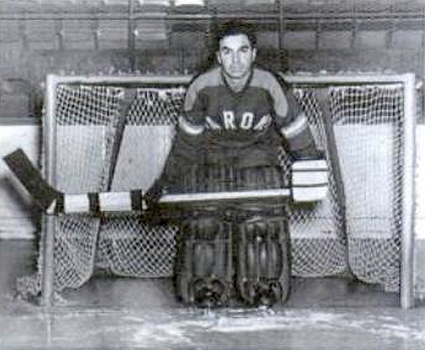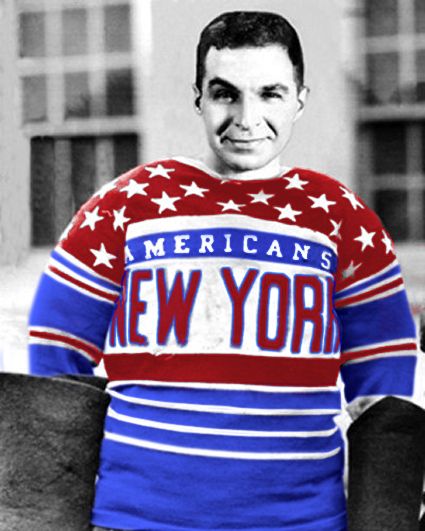Roberts would play one additional game for the Bruins on December 11th, a 5-3 loss to the short-lived Pittsburgh Pirates before Stewart was fit to return.
Roberts then spent the seven seasons in the Canadian-American Hockey League, beginning with the New Haven Eagles in 1926-27 with a 18-14-0 record and a 2.00 goals against average. After one more season with New Haven, Roberts joined the Philadelphia Arrows beginning with the 1928-29 season. Oddly, he had a losing 12-21-7 record that season despite a 1.76 goals against.
For the 1929-30 season, his goals against average rose more than a goal per game to 2.94, but his record improved to 20-18-2 as the Arrows found their offensive game, doubling their season total from 60 to 120.
Roberts would spend one more season with the Arrows in 1930-31 before returning to New Haven for the 1931-32 season. He also returned to the NHL for one game with the New York Americans on March 10, 1932 to replace an injured Roy Worters, a 5-1 win over the rival New York Rangers.
After playing the 1932-33 season for New Haven, Roberts joined the Cleveland Indians of the IHL for the 1933-34 season. He was limited to 35 games as he was recalled by the Americans of the NHL for another 6 games.
He would play the entire 1934-35 season with the newly renamed Cleveland Falcons before an unsettled 1935-36 season where Roberts played 13 games for the Falcons, 1 game for the Syracuse Stars and 15 for the Rochester Cardinals, all of the IHL.
Roberts played the majority of the 1941-42 season with the Barons as well as 3 games with the Pittsburgh Hornets after 16 seasons before his military obligations with the United States Navy due to World War II took him away from the game.
Five years after his last game, Roberts suited up for 24 games for the Washington Lions of the Eastern Amateur Hockey League before retiring from active play.
He returned to the game as the arena manager of the Milwaukee Gulls of the USHL in 1950-51 and then became the assistant team trainer for the Chicago Black Hawks the following season, which included putting on the pads during practice.
It was while on the Black Hawks staff on this date in 1951 that their goaltender Lumley, the same player who broke Roberts record as the youngest goaltender in NHL history, was injured in a game against the Detroit Red Wings. Roberts was pressed into service on an emergency basis 18 years after his last NHL appearance, setting a record as the oldest player in NHL history, which stood until Gordie Howe surpassed him in 1979. Roberts remains the oldest goaltender in league history.
Roberts final NHL totals were 10 games played with a 3-5 record and records at one time for being both the youngest and oldest players in the NHL. He was inducted into the United States Hockey Hall of Fame in 2005.
Today's featured jersey is a 1929-30 New York Americans Moe Roberts jersey. We will admit, this photo gives us some trouble. Roberts only played for the Americans in 1931-32 and 1933-34, but during those seasons, according to our favorite source NHLUniforms.com, the Americans wore jerseys with "AMERICANS" across the front with less sleeve stripes beginning in 1930-32.
Roberts is pictured here with a jersey featuring "NEW YORK" as the main cresting, which was used by the franchise from 1925-26 through 1929-30, all of which had more sleeve stripes, including several thin ones as pictured below.
Based on the pattern of striping on the body below the "NEW YORK", one stripe of one color with all the stripes below being a different color, we believe this was the style worn by the Americans from 1927-28 to 1929-30 and photographed with a blue filter, which would render the red areas darker and the blue areas lighter. We then colorized the photo to reflect this belief.
Now, why would Roberts be wearing a two year old 1929-30 jersey in 1931-32? Were teams not quite so fussy back then? Would a one game call up be given whatever spare jersey was around? Would a one game call up even be photographed in the first place? Perhaps this picture is from 1933-34 when Roberts was with the team for six games, making this 1929-30 jersey even more of an anomaly. We have our favorite opinion, but no way of knowing the real story behind this discrepancy.
















No comments:
Post a Comment
We welcome and encourage genuine comments and corrections from our readers. Please no spam. It will not be approved and never seen.